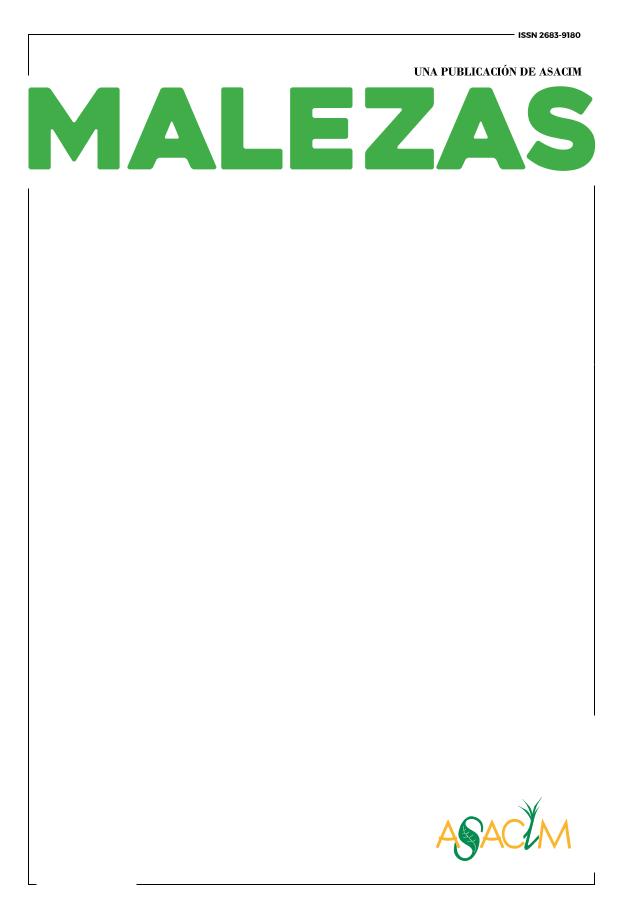Artículo
Amaranthus hybridus L. (yuyo colorado) es actualmente una de las especies maleza más problemáticas en los sistemas de producción de cultivos primavera estivales. Durante diciembre y febrero (2018-2019) se estudió en la Facultad de Ciencias Agrarias de la UNR y la Facultad de Agronomía de la UBA, la respuesta a distintos herbicidas de 50 poblaciones de A. hybridus. Los individuos de cada una de las poblaciones estudiadas se obtuvieron a partir de semillas cosechadas en lotes de producción de soja de diferentes áreas de producción, durante la campaña 2017-18. Se evaluó la respuesta a 2,4-D (1140 g e.a. ha-1), dicamba (560 g e.a. ha-1), fomesafén (250 g ha-1), topramezone (34 g ha-1) y glifosato (1080 g e.a. ha-1). Los herbicidas se aplicaron en cabina estática con un volumen de 140 l ha-1 y sobre plantas entre 2 a 6 hojas. A los 30 días de aplicados se cuantificó la supervivencia de individuos para cada tratamiento. En el conjunto de las poblaciones 84% y 76% fueron absolutamente susceptibles (supervivencia 0%) a 2,4-D y dicamba, respectivamente. No se identificaron poblaciones absolutamente susceptibles a los otros herbicidas evaluados. El 43%, 72% y 82% de las poblaciones presentaron supervivencia mayor a 60% a fomesafén, topramezone y glifosato, respectivamente. Más del 90% de las poblaciones presentaron elevados valores de supervivencia a glifosato, sin embargo, siguen encontrándose algunas susceptibles. Las diferencias en los valores de supervivencia permiten inferir la existencia de variabilidad genética para estos modos de acción, sobre la que podrían actuar los herbicidas, promoviendo procesos de selección de resistencia. Los resultados obtenidos sugieren la necesidad prioritaria de aplicar otras prácticas de manejo culturales que conserven la utilidad y la eficacia de los diferentes herbicidas, particularmente de los auxínicos. Amaranthus hybridus L. (pigweed) is currently one of the most problematic weed species in spring-summer crop production systems During December and February (2018-19) the response to different herbicides from fifty populations of A. hybridus was studied at the Faculty of Agronomy (UNR) and the Faculty of Agronomy (UBA). Individuals from each of the studied populations were obtai - ned from seeds harvested in soybean fields from different production areas, during the 2017-18 season. The response to 2,4-D (1140 g e. a.ha-1), Dicamba (560 g e.a. ha-1), Fomesafén (250 g ha-1), Topramezone (34 g ha-1) and Glyphosate (1080 g e.a. ha-1) were evaluated. Herbi - cides were applied in a static cabin with volume of 140 l ha-1 and 30 days after application, the survival of individuals was quantified for each treatment. In all the populations, 84% and 76% were absolutely susceptible (survival 0%) to 2,4-D and Dicamba, respectively. There were not totally susceptible populations to the other herbicides evaluated. The 43%, 72% and 82% of the populations presented survival greater than 60% to fomesafén, topramezone and glyphosate, respectively. More than 90% of the populations presented high glyphosate survival values, however some susceptible ones are still found. The differences in survival values allow us to infer the existence of genetic variability for these modes of action, on which herbicides could act, promoting resistance selection processes. The results obtained suggest the priority to apply management practices that preserve the usefulness and efficacy of different herbicides, particularly auxinics.
Respuesta a herbicidas con diferentes modos de acción (HRAC) en poblaciones de Amaranthus hybridus L. de la Argentina
Scursoni, Julio Alejandro; Vila Aiub, Martin Miguel ; Tuesca, Daniel Horacio; Balassone, Federico Emmanuel
; Tuesca, Daniel Horacio; Balassone, Federico Emmanuel ; Morello, Juan Pablo; Medina Herrera, Daniela; Lescano Martinez, María Cecilia; Montero Bulacio, Nicolás; Crespo, Roberto Javier; Depetris, María Rosa
; Morello, Juan Pablo; Medina Herrera, Daniela; Lescano Martinez, María Cecilia; Montero Bulacio, Nicolás; Crespo, Roberto Javier; Depetris, María Rosa
 ; Tuesca, Daniel Horacio; Balassone, Federico Emmanuel
; Tuesca, Daniel Horacio; Balassone, Federico Emmanuel ; Morello, Juan Pablo; Medina Herrera, Daniela; Lescano Martinez, María Cecilia; Montero Bulacio, Nicolás; Crespo, Roberto Javier; Depetris, María Rosa
; Morello, Juan Pablo; Medina Herrera, Daniela; Lescano Martinez, María Cecilia; Montero Bulacio, Nicolás; Crespo, Roberto Javier; Depetris, María Rosa
Fecha de publicación:
11/2020
Editorial:
Asociación Argentina de Ciencia de las Malezas
Revista:
Malezas
ISSN:
2683-9180
Idioma:
Español
Tipo de recurso:
Artículo publicado
Clasificación temática:
Resumen
Palabras clave:
HERBICIDAS AUXÍNICOS
,
FOMESAFEN
,
TOPRAMEZONE
,
GLIFOSATO
Archivos asociados
Licencia
Identificadores
Colecciones
Articulos(CCT - ROSARIO)
Articulos de CTRO.CIENTIFICO TECNOL.CONICET - ROSARIO
Articulos de CTRO.CIENTIFICO TECNOL.CONICET - ROSARIO
Articulos(IFEVA)
Articulos de INST.D/INV.FISIOLOGICAS Y ECO.VINCULADAS A L/AGRIC
Articulos de INST.D/INV.FISIOLOGICAS Y ECO.VINCULADAS A L/AGRIC
Citación
Scursoni, Julio Alejandro; Vila Aiub, Martin Miguel; Tuesca, Daniel Horacio; Balassone, Federico Emmanuel; Morello, Juan Pablo; et al.; Respuesta a herbicidas con diferentes modos de acción (HRAC) en poblaciones de Amaranthus hybridus L. de la Argentina; Asociación Argentina de Ciencia de las Malezas; Malezas; 4; 11-2020; 72-84
Compartir



